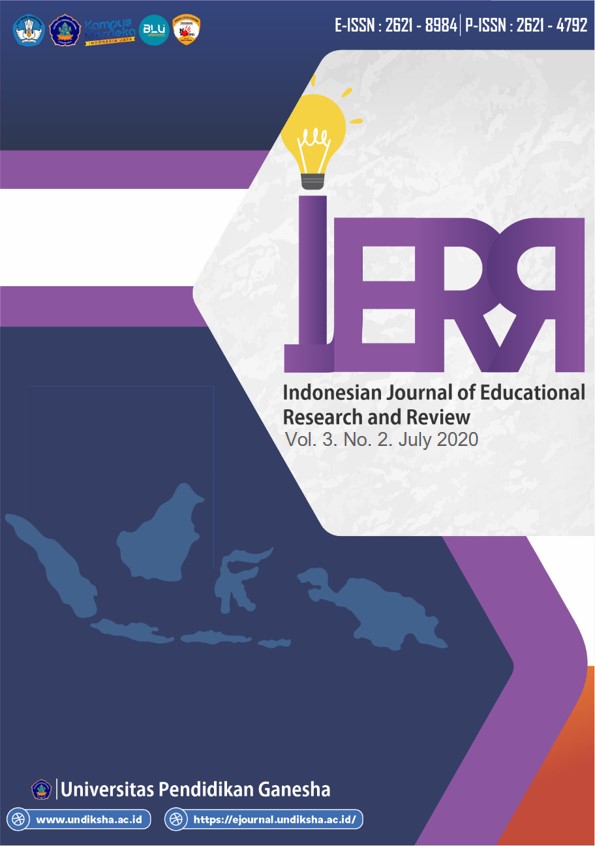The Analysis Of The Quality Of Teacher-Made Multiple-Choice Tests Used As Summative Assessment For English Subject
DOI:
https://doi.org/10.23887/ijerr.v3i2.25842Keywords:
Summative Assessment, Teacher-Made Multiple-Choice Test, Instrument Quality, NormsAbstract
This study arose in regards to the importance of constructing high quality multiple-choice tests (MCTs) that follow the norms in making a good MCT. The norms are considered important as they can make the tests relevant to the learning objectives and ease the test-takers in taking the test. This study which aimed to investigate the quality of teacher-made MCTs used as summative assessment for English subject at SMP Laboratorium Universitas Pendidikan Ganesha. 3 teacher-made MCTs with 40 items for each test were taken as the samples that represent each grade. The data were collected through document study by comparing each of the teacher-made MCTs item with the norms in making a good MCT that were then clarified through interview. The comparison is then classified in order to determine the quality. The results show that the quality of the teacher-made MCTs are very good with 106 items (88%) qualified as very good and 14 items (12%) that qualified as good. However, there are some norms that need more attention as they are rarely fulfilled.
References
Adeel. (2005). The Criteria and Analysis of Good Multiple Choice Questions in a Health Professional Setting. Saudi Arabia: King Saud University.
Anandan. (2015). Assessment for Learning. Tiruchirapplli: Bharathidasan University.
Atmowardoyo, H. (2018). Research Methods in TEFL Studies: Descriptive Research, Case Study, Error Analysis, and R&D. Journal of Language Teaching and Research. 9(1). 197-204. DOI: http://dx.doi.org/10.17507/jltr.0901.25
Black, P. & William, D. (1998a). “Assessment and Classroom Learning.” Assessment in Education: Principles, Policy, and Practice. 5(1). 7-73.
Brown, H. D. (2004). Language Assessment: Principles and Classroom Practices. White plains, NY: Pearson Education.
Burton, S. J., Sudweeks, R. R., Merril, P. F., & Wood, B. (1991). How to Prepare Better Multiple-Choice Test Items: Guidelines for University Faculty. Brigham Young University.
Fiktorius, T. (2004). A Validation Study on National English Examination of Junior High School in Indonesia. Pontianak: Tanjung Pura University.
Haladyna, T. M. (2004). Developing and Validiting Multiple-Choice Test Items Mahwah, New Jersey, London: Lawrence Erlbaum Associates.
Hall, C. & Marshall, S. (2013). A Guide for Developing Multiple-Choice and Other Objective Style Questions. Centre for Academic Development, Victoria University of Wellington, New Zealand.
Jabbarifar, T. (2009). The Importance of Classroom Assessment and Evaluation in Educational System. Proceedings of the 2nd International Conference of Teaching and Learning.
Kurniawan, A. (2016). Graduate Students’ Lived Experience in Writing Academic Papers. Sanata Darma University: Yogyakarta.
Kusumawati & Hadi. (2018). An Analysis of Multiple Choice Questions (MCQs): Item and Test Statistics from Mathematics Assessments in Senior High School, 4(1),70-78.
Lipson, M. Y. (1982). Learning New Information from Text: The Role of Prior Knowledge and Reading Ability. Journal of Reading Behavior. 14(3). 243-261.
Ministerial of Education and Culture of Indonesia. (2016). Regulation of the Ministry of Education and Culture of the Republic of Indonesia Number 23 of 2016 Regarding the Standard of Education Assessment. Jakarta, Indonesia.
Ministerial of Education and Culture of Indonesia. (2018). Regulation of the Ministry of Education and Culture of the Republic of Indonesia Number 4 of 2018 Regarding the Assessment of Learning Outcomes by the Educational Unit and Assessment of Learning Outcomes by the Government.
Nurkancana and Sunartana. (1992). Evaluasi Hasil Belajar. Surabaya: Usaha Nasional.
Puspendik Kemendikbud. (2019). Average score of 2016/2017 school year grade. [online]. Available: https://hasilun.puspendik.kemendikbud.go.id/
Puspendik Kemendikbud. (2019). Average score of 2017/2018 school year grade. [online]. Available: https://hasilun.puspendik.kemendikbud.go.id/
Puspendik Kemendikbud. (2019). Average score of 2018/2019 school year grade. [online]. Available: https://hasilun.puspendik.kemendikbud.go.id/
Puspendik Kemendikbud. (2019). Guidelines for Implementing Test Construction Training. Jakarta Indonesia.
Sunardi, & Sugini, S. (2014). The Effectiveness of a Two-day Inclusion Workshop on Teachers' Attitudes, Understanding, and Competence in Inclusive Education. The World Journal of Education. 4(1). 77-85.
Toksöz, S., & Ertunç, A. (2017). Item Analysis of a Multiple-Choice Exam. Advances in Language and Literary Studies. 8. 141.
Truss, L. (2003). Eats shoots and leaves: The Zero Tolerance Approach to Punctuation. New York: Gotham Books.
Tsagari, C. (1994). Method effects on testing reading comprehension: How far can we go? (Unpublished MA thesis). University of Lancaster: UK.
Wessels, S. (2012). The Importance of Activating and Building Knowledge. University of Nebraska: Lincoln.
Williams, C. (2007). Research Methods. Journal of Business & Economic Research. 5(3). 65-72.
Yeh, Y. F. (2012). Teaching Language and Culture: The Importance of Prior Knowledge when Reading Chinese as a Second Language. Journal of Multilingual Education Research. 3(6). 91-122.
Zimmaro, D. M. (2016). Writing Good Multiple-Choice Exams. University of Texas: USA.
Downloads
Published
How to Cite
Issue
Section
License
Authors who publish with the Indonesian Journal of Educational Research and Review (IJERR) agree to the following terms:
- Authors retain copyright and grant the journal the right of first publication with the work simultaneously licensed under a Creative Commons Attribution-ShareAlike 4.0 International License. that allows others to share the work with an acknowledgment of the work's authorship and initial publication in this journal.
- Authors are able to enter into separate, additional contractual arrangements for the non-exclusive distribution of the journal's published version of the work (e.g., post it to an institutional repository or publish it in a book), with an acknowledgment of its initial publication in this journal.
- Authors are permitted and encouraged to post their work online (e.g., in institutional repositories or on their website) prior to and during the submission process, as it can lead to productive exchanges, as well as earlier and greater citation of published work. (See The Effect of Open Access)









